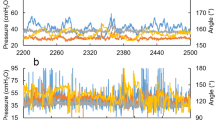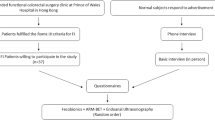Abstract
Background
Rectal evacuation involves multiple mechanisms that are not completely understood. The aim of this study was to quantify the rheologic property, i.e., yield stress, which governs the ease of deformation of a range of faeces of differing consistency and understand its influence on the pathophysiology of defaecation.
Methods
Yield stresses of faeces of differing consistencies and Bristol scores were determined by the Vane test. We then explored the effects of this property on ease of defecation using a simple static model of the recto-anal junction based on the laws of flow for yield stress pastes and checked the conclusions by X-ray defaecography experience.
Results
The yield stress of faeces increased exponentially with their solid content, from 20 to 8000 Pa. The static model of the recto-anal junction showed that evacuation of faeces of normal consistency and yield stress is possible with moderate dilatation of the anal canal, whilst the evacuation of faeces with higher yield stress requires greater dilatation of the anal canal. X-ray defaecography showed that such increases occurred in vivo.
Conclusions
The diameter of the recto-anal junction is increased to enable the passage of feces with high yield stress. The finite limits to such dilation likely contribute to fecal impaction. Hence, difficulties in defaecation may result either from unduly high yield stress or pathologies of reflex recto-anal dilatation or a combination of the two.


Similar content being viewed by others
References
Whitehead WE et al (2009) Fecal incontinence in US adults: epidemiology and risk factors. Gastroenterology 137:512–517
Perry S et al (2002) Prevalence of faecal incontinence in adults aged 40 years or more living in the community. Gut 50:480–484
Andromanakos N, Skandalakis P, Troupis T, Filippou D (2006) Constipation of anorectal outlet obstruction: pathophysiology, evaluation and management. J Gastroenterol Hepatol 21:638–646
Lunniss PJ, Gladman MA, Benninga MA, Rao SS (2009) Pathophysiology of evacuation disorders. Neurogastroenterol Motil 21:31–40
Bharucha AE, Fletcher JG (2007) Recent advances in assessing anorectal structure and functions. Gastroenterology 133:1069–1074
Carrington EV et al (2018) Expert consensus document: advances in the evaluation of anorectal function. Nat Rev Gastroenterol Hepatol 15:309–323
Corsetti M et al (2019) First translational consensus on terminology and definitions of colonic motility in animals and humans studied by manometric and other techniques. Nat Rev Gastroenterol Hepatol. https://doi.org/10.1038/s41575-019-0167-1
Petros P et al (2012) Defecation 1: testing a hypothesis for pelvic striated muscle action to open the anorectum. Tech Coloproctol 16:437–443
Stokes WE, Jayne DG, Alazmani A, Culmer PR (2019) A biomechanical model of the human defecatory system to investigate mechanisms of continence. Proc Inst Mech Eng [H] 233:114–126
Hajivassiliou CA, Carter KB, Finlay IG (1996) Anorectal angle enhances faecal continence. BJS 83:53–56
Picologlou BF, Patel PD, Lykoudis PS (1973) Biorheological aspects of colonic activity. I. Theoretical considerations. Biorheology 10:431–440
Farag A (1998) Use of the Hagen–Poiseuille law: a new mathematical approach for the integration and evaluation of anorectal physiological testing in patients with faecal incontinence and pelvic dyschezia and in normal controls. Eur Surg Res 30:279–289
Lentle RG, Janssen PW (2011) The physical processes of digestion. Springer Science & Business Media, New York
Bush M, Petros P, Swash M, Fernandez M, Gunnemann A (2012) Defecation 2: internal anorectal resistance is a critical factor in defecatory disorders. Tech Coloproctol 16:445–450
Yang JP, LaMarca M, Kaminski C, Chu ID, Hu LD (2017) Hydrodynamics of defecation. Soft Matter 13:4960–4970
Palit S, Lunniss PJ, Scott SM (2012) The physiology of human defecation. Dig Dis Sci 57:1445–1464
Longstreth GF et al (2006) Functional bowel disorders. Gastroenterology 130:1480–1491
Penn R, Ward BJ, Strande L, Maurer M (2018) Review of synthetic human faeces and faecal sludge for sanitation and wastewater research. Water Res 132:222–240
Woolley SM, Cottingham RS, Pocock J, Buckley CA (2014) Shear rheological properties of fresh human faeces with different moisture content. Water Sa 40:273–276
Patel PD, Picologlou BF, Lykoudis PS (1973) Biorheological aspects of colonic activity. II. Experimental investigation of the rheological behavior of human feces. Biorheology 10:441–445
Lentle RG, Hemar Y, Hall CE (2006) Viscoelastic behaviour aids extrusion from and reabsorption of the liquid phase into the digesta plug: creep rheometry of hindgut digesta in the common brushtail possum Trichosurus vulpecula. J Comp Physiol [B] 176:469–475
Krieger IM, Dougherty TJ (1959) A mechanism for non-newtonian flow in suspensions of rigid spheres. Trans Soc Rheol 3:137–152
Hardacre AK, Lentle RG, Yap SY, Monro JA (2018) Predicting the viscosity of digesta from the physical characteristics of particle suspensions using existing rheological models. J R Soc Interface 15:20180092
Lentle RG et al (2008) High-definition spatiotemporal mapping of contractile activity in the isolated proximal colon of the rabbit. J Comp Physiol [B] 178:257–268
Coussot P (2014) Yield stress fluid flows: a review of experimental data. J Non-Newton Fluid Mech 211:31–49
Balmforth NJ, Frigaard IA, Ovarlez G (2014) Yielding to stress: recent developments in viscoplastic fluid mechanics. Annu Rev Fluid Mech 46:121–146
Faucheron JL, Barot S, Collomb D, Hohn N, Anglade D, Dubreuil A (2014) Dynamic cystocolpoproctography is superior to functional pelvic magnetic resonance imaging in the diagnosis of posterior pelvic floor disorders: results of a prospective study. Colorectal Dis 16:240–247
Lewis SJ, Heaton KW (1997) Stool form scale as a useful guide to intestinal transit time. Scand J Gastroenterol 32:920–924
Mahieu P, Pringot J, Bodart P (1984) Defecography: I. Description of a new procedure and results in normal patients. Gastrointest Radiol 9:247–251
Barnes HA, Nguyen QD (2001) Rotating vane rheometry—a review. J Non-Newton Fluid Mech 98:1–14
Liddel PV, Boger DV (1996) Yield stress measurements with the vane. J Non-Newton Fluid Mech 63:235–261
Dzuy NQ, Boger DV (1983) Yield stress measurement for concentrated suspensions. J Rheol 27:321–349
Nguyen QD, Boger DV (1992) Measuring the flow properties of yield stress fluids. Annu Rev Fluid Mech 24:47–88
Shafik A, Shafik AA, El-Sibai O, Ali YA (2003) Videodefecography: a study of the rectal motile pattern. Surg Radiol Anat 25:139–144
Bryan MP, Rough SL, Wilson DI (2017) Flow visualisation and modelling of solid soap extrusion. Chem Eng Sci 173:110–120
Horrobin DJ, Nedderman RM (1998) Die entry pressure drops in paste extrusion. Chem Eng Sci 53:3215–3225
McCulloch P, Altman DG, Campbell WB et al (2009) No surgical innovation without evaluation: the IDEAL recommendations. Lancet 374:1105–1112
Saha PK (2000) Aluminum extrusion technology. Asm International, Cleveland
Faucheron JL, Dubreuil A (2000) Rectal akinesia as a new cause of impaired defecation. Dis Colon Rectum 43:1545–1549
Barnes HA, Hutton JF, Walters K (1989) An introduction to rheology. Elsevier, Amsterdam
Hardacre AK, Yap SY, Lentle RG, Janssen PWM, Monro JA (2014) The partitioning of water in aggregates of undigested and digested dietary particles. Food Chem 142:446–454
Zbar AP, Guo M, Pescatori M (2008) Anorectal morphology and function: analysis of the Shafik legacy. Tech Coloproctol 12:191
Kamm M, Van Der Sijp JM, Lennard-Jones J (1992) Colorectal and anal motility during defaecation. Lancet 339:820
Li D, Guo M (2007) Morphology of the levator ani muscle. Dis Colon Rectum 50:1831–1839
Wood JD (2006) Integrative functions of the enteric nervous system. Physiology of the gastrointestinal tract. Elsevier, Amsterdam, pp 665–683
O’Donnell LJ, Virjee J, Heaton KW (1990) Detection of pseudodiarrhoea by simple clinical assessment of intestinal transit rate. BMJ 300:439–440
Exton-Smith AN, Bendall MJ, Kent F (1975) A new technique for measuring the consistency of faeces: a report on its application to the assessment of Senokotot therapy in the elderly. Age Ageing 4:58–62
Aichbichler BW et al (1998) A comparison of stool characteristics from normal and constipated people. Dig Dis Sci 43:2353–2362
Nakaji S et al (2002) New method for the determination of fecal consistency and its optimal value in the general population. J Gastroenterol Hepatol 17:1278–1282
Faucheron JL, Sage PY, Trilling B (2018) Videodefecography is still superior to magnetic resonance defecography in the study of obstructed defecation syndrome. Tech Coloproctol 22:321–322
Acknowledgements
The authors gratefully acknowledge Dr. François Laporte (Nutritional Biology and Oxidative Stress Unit, University Hospital, Grenoble) to have given them the authorization to perform the rheological measurements in his laboratory, and Prof. Bruno Bonaz (Gastroenterology Unit, University Hospital, Grenoble) to have given them the authorization to collect part of the material in his unit.
Funding
This work has been partially supported by the LabEx Tec 21 (Investissements d'Avenir—Grant agreement #ANR-11-LABX-0030). LRP is part of Institut Carnot PolyNat (Investissements d'Avenir—Grant agreement #ANR-11-CARN-030-01). RG Lentle thanks the Labex Tec21 for the funding of his stay at the Laboratoire Rhéologie et Procédés.
Author information
Authors and Affiliations
Corresponding author
Ethics declarations
Conflict of interest
The authors declare that no conflict of interest exists.
Ethical approval
The study has been performed in accordance with the ethical standards as laid down in the 1964 Declaration of Helsinki and its later amendments.
Informed consent
For this type of study, formal consent is not required.
Additional information
Publisher's Note
Springer Nature remains neutral with regard to jurisdictional claims in published maps and institutional affiliations.
Rights and permissions
About this article
Cite this article
de Loubens, C., Dubreuil, A., Lentle, R.G. et al. Rheology of human faeces and pathophysiology of defaecation. Tech Coloproctol 24, 323–329 (2020). https://doi.org/10.1007/s10151-020-02174-0
Received:
Accepted:
Published:
Issue Date:
DOI: https://doi.org/10.1007/s10151-020-02174-0




